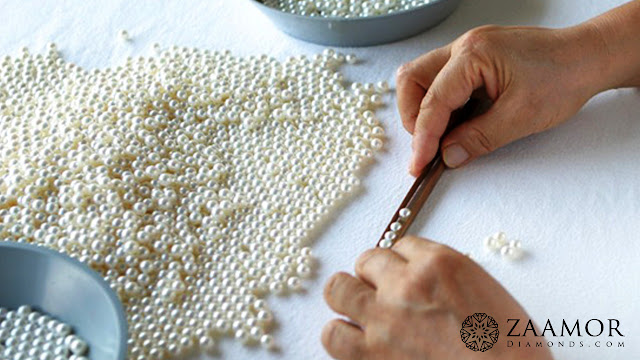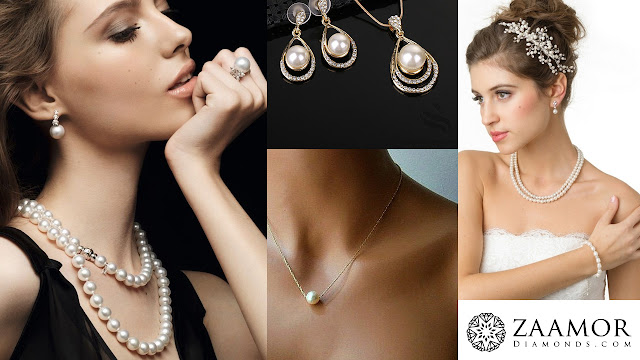Pearls are versatile! Pearl jewelry is great with an evening dress at a formal ball or with jeans and a blouse at lunch with frien...
Pearls are versatile! Pearl jewelry is great with an evening dress at a formal ball or with jeans and a blouse at lunch with friends. Since each pearl is a unique creation, each piece of pearl jewelry is unique, too. Once you learn how to buy pearls of quality, you can add plenty of jewelry with gleaming pearls to your collection. Let us help you select pearl jewelry with our pearl knowledge and jewelry buying tips.
Origin of Pearls
Pearls are the only gem that grows naturally in a living organism. Any mollusk with a shell -- oysters, clams, snails -- can produce a pearl, but pearls mostly grow in oysters. Pearls grow when a small irritant is caught in the oyster's tissue. The oyster covers the irritant with nacre, also called mother-of-pearl; thus, the small invader becomes the nucleus of a pearl. The layers of nacre keep accumulating as long as the pearl stays in the oyster.
Natural and Cultured Pearls
Mollusks are found in all oceans and many rivers and lakes, but freshwater pearls and saltwater pearls that are good enough to be included in jewelry are so rare that, historically, they've been limited to the wealthy. Today, the farm grown or cultured pearl is affordable to almost anyone. Most modern pearl jewelry uses cultured pearls; they are real pearls, just made with a little help from humans. The process begins when a "nucleus" is implanted in an oyster, instead of waiting and hoping for it to happen naturally. Since mollusks simply can't keep up with the demand for pearls, growing cultured pearls is now a major industry. Natural oyster pearls are still available, most often in vintage estate jewelry.
Types of pearls: You can choose from a variety of pearls; each type of pearl offers a different aesthetic.
Akoya Pearl: This is the original cultured pearl, farmed in the coastal waters of Japan and China. They measure 2 to 10 mm in diameter, averaging 6 to 7 mm. These cultured pearls are consistently round, so a cultured pearl necklace is very likely made of Akoyas.
Freshwater Pearls: Farmed in lakes and rivers, most freshwater pearls on the market originate in China. The size range is 2 to 13 mm, averaging 6 to 7 mm. Freshwater pearls are white when harvested, but jewelry manufacturers dye the pearls in many colors. The dyed black pearls can have rainbow iridescence, a unique characteristic of freshwater pearls.
Keshi Pearls: When an oyster spits out the nucleus, it might still produce a pearl. Because the nucleus-free pearl is an accidental by-product of the cultured process, it is still considered a cultured pearl, even though it's solid nacre. Keshi pearls come from saltwater or freshwater pearl farms, but modern farming techniques have made keshis rare though they were formerly common.
Mabe Pearls (pronounced MAH-BEE): Mabe pearls grow against the oyster shell. This "blister" pearl is hemispherical in shape. Once harvested, the nucleus is replaced by resin, and the flat back is covered in mother-of-pearl. Mabe pearls have very high luster and are less expensive than rounds.
South Sea Pearls: Cultured in the waters between Australia and China, these are among the largest cultured pearls, ranging from 10 to 20 mm in diameter, averaging about 13 mm. South Sea pearls are naturally white, cream or gold.
Tahitian Pearls: Cultured all over French Polynesia but traded from Tahiti, a Tahitian pearl is a naturally grey, silver or black pearl that measures 8 to 16 mm in diameter. The most sought after Tahitian pearl is black with peacock green overtones.
Pearl quality
The jewelry industry grades pearl quality using these factors:
Size: Pearls are measured in millimeters; 25.4 millimeters equals 1 inch, so a 6-mm pearl is just under one-quarter-inch in diameter.
Color: The natural pearl colors feature various shades of white, gold and black, with creamy shades of white being the most common. Overtones, a translucent color that lies over the main body color of the pearl, and orient, iridescent colors in the pearl, give pearls interesting and unique hues.
Shape: Spherical pearls are the most sought-after for pearl bracelets and pearl necklaces. Pearls, however, come in many shapes, including drop, button, oval and flat, also known as coin. All these shapes are great for pearl rings, pearl earrings and non-jewelry decorations. The Shape depends on the oyster, its health, the temperature and chemistry of the water and other factors. Pearl farmers stack the odds by placing round nuclei into their oysters.
Luster: This is the way light travels through the pearl and reflects back to the eye. Because pearls are round, the layers act like mirrors, making pearls appear to glow from within. The luster grade depends on the sharpness of the reflected images.
Surface quality: Like diamonds, few pearls are perfect; blemishes on a pearl can be spots, pits or scratches. The highest-quality pearls have very few blemishes.
Nacre quality: This is the mother-of-pearl layers that form the pearl. The thicker and more even the layers of mother of pearl, the higher the quality.
Matching: This is important when considering a group of pearls for a pearl necklace, bracelet or jewelry set. Consistency in color and size of the pearls creates a more beautiful appearance for jewelry and increases the value.
Pearl grade
Pearls are graded on the factors listed above. Consider this grading system when choosing pearls and pearl jewelry. Please note that there are variances in the grades. For example, a pearl can have a shape other than round and still have an AAA grade.
AAA: Pearls have a high luster and graceful shape. They are precisely matched in size, color and overtone relevant to the piece. The pearls can have minute differences that are barely visible for most people.
AA: Pearls have a nice shape and a medium to high luster. These have good uniformity in size, color and overtone. Pearls can have slight blemishes on the surface that are noticed only when looking closely at the pearl.
A: Pearls have an even shape and a low to medium luster. These are nearly uniform in size, color and overtone. Pearls may have blemishes and/or wrinkles on the surface.
B: Pearls have uneven shapes and a low to poor luster. The size, color and overtone may vary within each strand. Pearls may have blemishes and wrinkles on the surface.
Pearl Care
When cared properly, pearls can last a lifetime. The best way to care for pearls is to wear them often as the body's natural oils keep pearls lustrous. However, it's important to keep them away from household chemicals including perfume, makeup and hairspray. Chemicals found in these common products can dull the luster of your pearls. It is recommended that you put your pearls on last when getting ready and make them the first thing you take off when you come home. Before putting your pearls away, wipe them with a soft cloth and store them separate from other jewelry to avoid scratching their tender surfaces.








